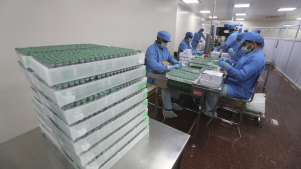Australia’s coronavirus vaccine strategy has received a boost with evidence showing Pfizer’s vaccine offers good protection against COVID-19’s new variants.
By Liam Mannix, The Sydney Morning Herald
Emerging data from Britain also suggests AstraZeneca’s much-maligned vaccine works just as well as Pfizer’s mRNA jab in the real world, with two doses of either vaccine cutting the risk of contracting COVID-19 by as much as 70 per cent.
Nurse Sioban Cheesman gives Angela Massie her AstraZeneca COVID-19 vaccine in Perth earlier this month.GETTY IMAGES“It’s really good news,” said Associate Professor James Wood, a leading vaccine expert at the University of NSW.
“It does present herd immunity as a much more achievable proposition in Australia, with our vaccine mix – with the caveat we don’t know what we’ll be seeing in six months’ time.”
The variant of COVID-19 first seen in South Africa, known as B.1.351, has a collection of mutations that appear to cut the ability of antibodies to stop it binding to and entering human cells.
Concern about that variant reached fever pitch when researchers published a study in March suggesting AstraZeneca’s vaccine offered no protection against catching it. But that small study was more suggestive than conclusive, and researchers are still waiting for better data to come in.
The New England Journal of Medicine last week printed a letter from Qatari-based scientists; about half that country’s cases are from the South African variant, with the Pfizer vaccine being quickly rolled out to quell a new outbreak.
After two doses, the Pfizer vaccine was about 70 per cent effective against the South African variant, and about 97 per cent effective against serious illness and death, they said.
“It’s reassuring,” said Professor Fiona Russell, an adviser to the World Health Organisation on vaccines, based at the Murdoch Children’s Research Institute.
“Certainly, Pfizer is a great vaccine. There is no doubt about that.”
However, the study is limited by the fact the researchers did not explicitly test each infected person to see if they had contracted the South African variant. They simply assumed that if they did not have the British variant they must have the South African virus.
“I’m not a big fan of that study,” said Professor Wood.
In clinical trials, Pfizer’s mRNA vaccine recorded an efficacy against symptomatic infection of about 95 per cent, while AstraZeneca’s was closer to 70 per cent, leading to concerns the AstraZeneca jab was inferior (despite both offering seemingly complete protection against severe illness and death).
But drugs often work differently in the outside world, compared to carefully controlled clinical trials.
A new British study, uploaded to medRxiv but not yet peer reviewed, found essentially no difference between the protection offered by Pfizer and AstraZeneca’s jabs.
The large study took swabs from a random selection of people every week; it collected more than 1.6 million swabs between December and April. It found that two doses of Pfizer or AstraZeneca cut the risk of catching COVID-19 by 70 per cent.
That makes earlier, similar findings in Scotland – where AstraZeneca’s vaccine was somehow more effective than Pfizer’s – appear more plausible (a US study published earlier this month put Pfizer’s real-world effectiveness at 90 per cent, but studied a much smaller number of people).
“Is that a surprise? No, not necessarily,” said Professor Russell. “Vaccinologists ... all thought probably most of the vaccines would work similarly and have a similar effectiveness.
RELATED ARTICLE
“A lot of the differences in clinical trial results are likely based on study design, the populations enrolled, the variants circulating. We have to wait and see, but what happens in the real world is the most important.”
One of the largest mysteries that remains about vaccines is how well they stop infected people passing on the virus. If they do it poorly, even high rates of vaccination are unlikely to stop the virus circulating.
In two separate British studies, researchers looked at thousands of households where a person fell sick. In cases where the sick person had received a vaccine, the chances of them passing on the virus to someone else in the house dropped by about 50 per cent.

